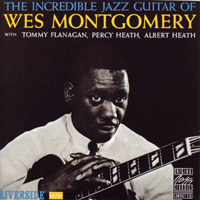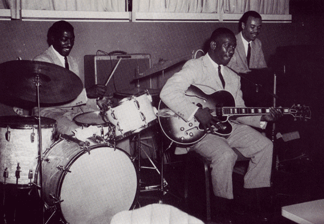

|
Soundclip:
|
| See Steve's Hand-Written Solo
Transcription |
Wes Mongtomery's solo on:
"Gone with the Wind"(Wrubel-Magidson) Often times, when you have been a fan of a particular artist, and have seen them perform live on countless occasions, then, when you go to buy their most recent recording, you find they have recorded with different musicians, more "well-known" musicians. And so, you are left to wonder, "Why did that happen?" In almost all cases, when you observe such a common phenomenon, it is because the record company, or their A&R executive, has told the artist that he might "reach a broader audience" if he played with more "familiar" names. Though I am certain that Wes Montgomery was thrilled to be playing with pianist Tommy Flanagan, bassist Percy Heath and drummer Albert "Tootie" Heath, when he recorded "THE INCREDIBLE JAZZ GUITAR OF WES MONTGOMERY"(Riverside),  I would be just as inclined to say that he would have been perfectly happy to have continued recording with his own organ trio from Indianapolis. Just as often, the artist is "asked" to interpret familiar or popular standards, tunes which he might not have been playing live. We all witnessed this during the latter stages of Wes' wonderful career. I don't believe that this was the case in January of 1960 when he recorded the great standard "Gone with the Wind." However, as I like to do, if you have never heard a vocal version of this wonderful song, you must go and investigate the versions of Frank Sinatra and/or Morgana King. Both interpretations are spectacularly beautiful and sad, showing the truly romantic side of this marriage of lyrics, melody, and harmony. I would be just as inclined to say that he would have been perfectly happy to have continued recording with his own organ trio from Indianapolis. Just as often, the artist is "asked" to interpret familiar or popular standards, tunes which he might not have been playing live. We all witnessed this during the latter stages of Wes' wonderful career. I don't believe that this was the case in January of 1960 when he recorded the great standard "Gone with the Wind." However, as I like to do, if you have never heard a vocal version of this wonderful song, you must go and investigate the versions of Frank Sinatra and/or Morgana King. Both interpretations are spectacularly beautiful and sad, showing the truly romantic side of this marriage of lyrics, melody, and harmony.This month, we are offering the one-chorus single-note portion of Wes' "Gone with the Wind" solo. Here, this great standard is in the classic [A][A'] or [A][A2] form, but Wes and the quartet interpret the tune a bit above what I would refer to as the "medium bounce" tempo. And that is obviously way out of the range if one was expecting a ballad. This particular tempo lends itself beautifully for Wes to utilize triplet figures throughout this particular chorus. During [A] look at bars: 7; 8-11; and during [A2] in bars: 17-21; 25-26; and 29-32. The long arpeggiated lines you see as phrases begin in [A2] were very characteristic of Wes' playing and you see such lines throughout the various recordings and phases of his career. As a student, if you simply isolate any one of them and practice it over and over, and over again, such things will flow directly out of you as they did for Wes. Of course, you will always know the "source" of those lines, but, we all have our influences, so there's nothing wrong with that!!! If one looks at the first 8 bars of either [A] or [A2], you can see that we have ii-Vs to Ebmaj7 and then ii-Vs to Gmaj7. What is of note is how Wes and the other players treat the 2nd half of bars 2 or 6. These 'turnarounds' can be interpreted diatonically by employing the simple I-vi [Ebmaj-Cm7 or Gmaj-Em7] type of approach/progression, but they can just as easily be played using I-VI7(alt.) approach [Ebmaj-C7(alt.) or Gmaj-E7(alt.)]. The VI7(alt.) chord can even be preceded by the iiim7 chord which you might hear as: | Gmaj7 / Bm7 E7(alt.) | headed to Am7. This would vary from performance to performance, and is reserved for moment-to-moment choices in lines and accompaniment. The 'blues' plays a most active role as Wes interprets this standard. This element is first introduced in his pick-up to the solo if you notice the usage of a Db and another 'blue note' the A-natural and Gb as well. At [A], during the first 4 bars, Wes utilizes the C minor pentatonic[C, Eb, F, G, Bb]. This particular application does not really reappear until the last two bars of [A2]. As the tune passes through G major as well, you can see some bluesy elements in [A], bar 6; and in [A2], bars 22; and 23-24. Another element in Wes' general approach to improvising is the usage of simple triads which serve, oftens times, to extend the harmony. If you just focus on bars 5-8 in [A], you can see a B-triad over the D7 chord which produces the b9; & 13th. Then, in bar 7, in the second half of the bar he employs a simple 'D' augmented triad but lands on an Eb(b9) before using the Ab(b5) as an upper neighbor to the target note of 'G', the root. The use of an augmented triad appears again in [A2], bar 19, over the Bb7(alt.) chord on beat 3. Thematic development plays a most important role in this solo too. During [A], from bars 8-12 offers a simple idea which continues. At [A2], in the first bar of each 4-bar phrase, Wes uses a vaulting arpeggio to begin the phrase. In bars 29 and 30, through the parallel descending ii-Vs: | F#m7 / B7 / | Fm7 / Bb7 / | Wes uses his arpeggios, but introduces the element of the b5 as well. Notice the F-natural[b5 of B7] and the E-natural[b5 of Bb7].  The usage of this type of chord movement appears in any number of standards as interpreted by the best Jazz musicians. Normally, one could play the tune by using one bar of Fm7 and one bar of Bb7, as simple as that. The inclusion of the extra ii-V, one half-step above, going down to the expected ii-V, only adds to the improvising challenge. Wes Montgomery often approached these types of progressions, descending non-resolving ii-Vs by using repeated sequences. This as opposed to joining the linear ideas at the point where one ii-V just happened to end. The usage of this type of chord movement appears in any number of standards as interpreted by the best Jazz musicians. Normally, one could play the tune by using one bar of Fm7 and one bar of Bb7, as simple as that. The inclusion of the extra ii-V, one half-step above, going down to the expected ii-V, only adds to the improvising challenge. Wes Montgomery often approached these types of progressions, descending non-resolving ii-Vs by using repeated sequences. This as opposed to joining the linear ideas at the point where one ii-V just happened to end.Though it is an often overlooked element, in this solo, Wes uses almost the entire range of the instrument. At one point, in bar 6 of [A], he hits a low 'G', and then, later, in [A2] at bar 17, he hits a high 'G'. However, like most of the best players, the better portion of the solo is spent in the warmer areas of the guitar, which means, never 'camping out' too high, nor too low. We began this discussion by addressing issues of why artists record with musicians who are not the same ones with whom they travel. And, we mentioned that artists often record material with which they are not familiar. Please don't misunderstand me, Wes Montgomery sounds absolutely familiar with "Gone with the Wind." He interprets its melody, as he did many other tunes, in a very 'playful' manner, almost devoid of a sense of romance. He seems so comfortable playing this tune that, if one was not familiar with it, you might not even recognize it. The feeling is almost as if he is improvising right from the start. Once again, it is my hope that you will enjoy this glimpse into the work of a truly great artist. Here's wishing everyone a very safe and Happy Halloween!!! Boo!!!
[Photo of Wes Montgomery with Sonny Johnson and Mel Rhyne
by Duncan Scheidt, at the "500 Room" of the Essex House Hotel, Indianapolis, Indiana, 1959. From the book, "WES MONTGOMERY" by Adrian Ingram] |